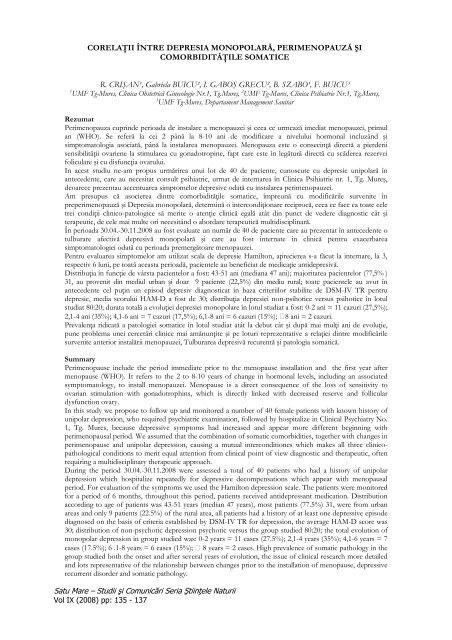satu mare studii şi comunicări seria ştiinţele naturii - Muzeul ...
satu mare studii şi comunicări seria ştiinţele naturii - Muzeul ...
satu mare studii şi comunicări seria ştiinţele naturii - Muzeul ...
Create successful ePaper yourself
Turn your PDF publications into a flip-book with our unique Google optimized e-Paper software.
CORELAŢII ÎNTRE DEPRESIA MONOPOLARĂ, PERIMENOPAUZĂ ŞI<br />
COMORBIDITĂŢILE SOMATICE<br />
R. CRIŞAN¹, Gabriela BUICU², I. GABOŞ GRECU², B. SZABO¹, F. BUICU³<br />
1 UMF Tg-Mures, Clinica Obstetrică Ginecologie Nr.1, Tg.Mureş, 2 UMF Tg-Mures, Clinica Psihiatrie Nr.1, Tg.Mureş,<br />
3 UMF Tg-Mures, Departament Management Sanitar<br />
Rezumat<br />
Perimenopauza cuprinde perioada de instalare a menopauzei şi ceea ce urmează imediat menopauzei, primul<br />
an (WHO). Se referă la cei 2 până la 8-10 ani de modificare a nivelului hormonal incluzând şi<br />
simptomatologia asociată, până la instalarea menopauzei. Menopauza este o consecinţă directă a pierderii<br />
sensibilităţii ovariene la stimularea cu gonadotropine, fapt care este în legătură directă cu scăderea rezervei<br />
foliculare şi cu disfuncţia ovarului.<br />
In acest studiu ne-am propus urmărirea unui lot de 40 de paciente, cunoscute cu depresie unipolară în<br />
antecedente, care au necesitat consult psihiatric, urmat de internarea în Clinica Psihiatrie nr. 1, Tg. Mureş,<br />
deoarece prezentau accentuarea simptomelor depresive odată cu instalarea perimenopauzei.<br />
Am presupus că asocierea dintre comorbidităţile somatice, împreună cu modificările survenite în<br />
preperimenopauză şi Depresia monopolară, determină o intercondiţionare reciprocă, ceea ce face ca toate cele<br />
trei condiţii clinico-patologice să merite o atenţie clinică egală atât din punct de vedere diagnostic cât şi<br />
terapeutic, de cele mai multe ori necesitând o abordare terapeutică multidisciplinară.<br />
În perioada 30.04.-30.11.2008 au fost evaluate un număr de 40 de paciente care au prezentat în antecedente o<br />
tulburare afectivă depresivă monopolară şi care au fost internate în clinică pentru exacerbarea<br />
simptomatologiei odată cu perioada premergătoare menopauzei.<br />
Pentru evaluarea simptomelor am utilizat scala de depresie Hamilton, aprecierea s-a făcut la internare, la 3,<br />
respectiv 6 luni, pe toată aceasta perioadă, pacientele au beneficiat de medicaţie antidepresivă.<br />
Distribuţia în funcţie de vârsta pacientelor a fost: 43-51 ani (mediana 47 ani); majoritatea pacientelor (77,5% )<br />
31, au provenit din mediul urban şi doar 9 paciente (22,5%) din mediu rural; toate pacientele au avut în<br />
antecedente cel puţin un episod depresiv diagnosticat în baza criteriilor stabilite de DSM-IV TR pentru<br />
depresie, media scorului HAM-D a fost de 30; distribuţia depresiei non-psihotice versus psihotice în lotul<br />
studiat 80:20; durata totală a evoluţiei depresiei monopolare în lotul studiat a fost: 0-2 ani = 11 cazuri (27,5%);<br />
2,1-4 ani (35%); 4,1-6 ani = 7 cazuri (17,5%); 6,1-8 ani = 6 cazuri (15%); 8 ani = 2 cazuri.<br />
Prevalenţa ridicată a patologiei somatice în lotul studiat atât la debut cât şi după mai mulţi ani de evoluţie,<br />
pune problema unei cercetări clinice mai amănunţite şi pe loturi reprezentative a relaţiei dintre modificările<br />
survenite anterior instalării menopauzei, Tulburarea depresivă recurentă şi patologia somatică.<br />
Summary<br />
Perimenopause include the period immediate prior to the menopause installation and the first year after<br />
menopause (WHO). It refers to the 2 to 8-10 years of change in hormonal levels, including an associated<br />
symptomatology, to install menopauzei. Menopause is a direct consequence of the loss of sensitivity to<br />
ovarian stimulation with gonadotrophins, which is directly linked with decreased reserve and follicular<br />
dysfunction ovary.<br />
In this study we propose to follow up and monitored a number of 40 female patients with known history of<br />
unipolar depression, who required psychiatric examination, followed by hospitalize in Clinical Psychiatry No.<br />
1, Tg. Mures, because depressive symptoms had increased and appear more different beginning with<br />
perimenopausal period. We assumed that the combination of somatic comorbidities, together with changes in<br />
perimenopause and unipolar depression, causing a mutual interconditiones which makes all three clinicopathological<br />
conditions to merit equal attention from clinical point of view diagnostic and therapeutic, often<br />
requiring a multidisciplinary therapeutic approach.<br />
During the period 30.04.-30.11.2008 were assessed a total of 40 patients who had a history of unipolar<br />
depression which hospitalize repeatedly for depressive decompensations which appear with menopausal<br />
period. For evaluation of the symptoms we used the Hamilton depression scale. The patients were monitored<br />
for a period of 6 months, throughout this period, patients received antidepressant medication. Distribution<br />
according to age of patients was 43-51 years (median 47 years), most patients (77.5%) 31, were from urban<br />
areas and only 9 patients (22.5%) of the rural area, all patients had a history of at least one depressive episode<br />
diagnosed on the basis of criteria established by DSM-IV TR for depression, the average HAM-D score was<br />
30; distribution of non-psychotic depression psychotic versus the group studied 80:20; the total evolution of<br />
monopolar depression in group studied was: 0-2 years = 11 cases (27.5%); 2,1-4 years (35%); 4,1-6 years = 7<br />
cases (17.5%); 6 .1-8 years = 6 cases (15%); 8 years = 2 cases. High prevalence of somatic pathology in the<br />
group studied both the onset and after several years of evolution, the issue of clinical research more detailed<br />
and lots representative of the relationship between changes prior to the installation of menopause, depressive<br />
recurrent disorder and somatic pathology.<br />
Satu Mare – Studii şi Comunicări Seria Ştiinţele Naturii<br />
Vol IX (2008) pp: 135 - 137




